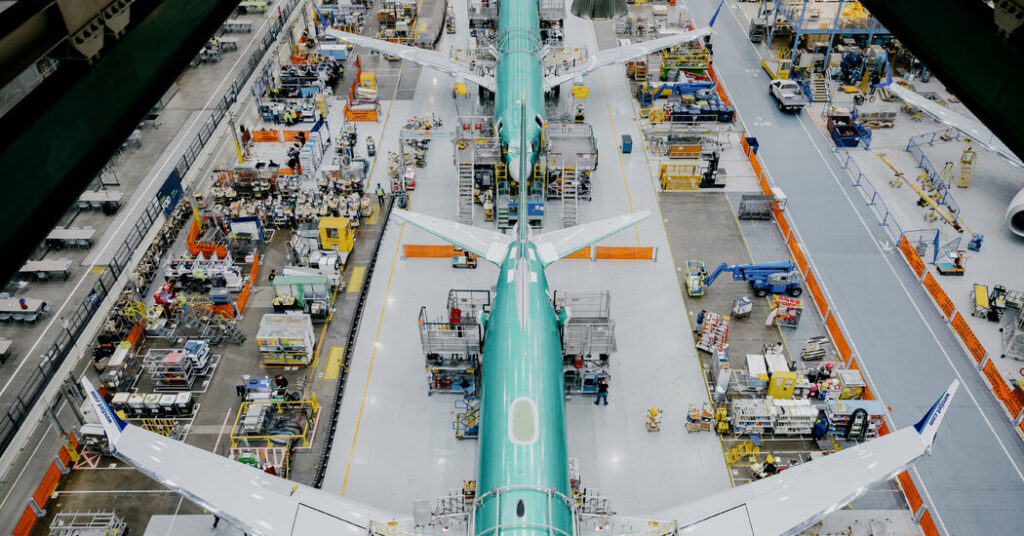The 737 Max starts its journey through a Boeing factory near Seattle when its empty central tube is hoisted onto a structure high above the floor. There, about a dozen workers fan out to search for defects.
That inspection is part of a new quality-control regimen at Boeing after a nightmarish episode nearly two years ago, when a part on a Max blew away at 15,000 feet, exposing passengers to roaring winds and potential catastrophe. No one was seriously injured, but the January 2024 episode prompted a reckoning.
Boeing installed new management and made wide-ranging changes at this factory in Renton, on the shore of Lake Washington. Some improvements were straightforward, such as tightening equipment arrival inspections, doing more jobs in their intended order and simplifying paperwork — changes that some aerospace experts say should have been made long ago. Other problems will be more difficult to address, like winning over workers who have complained for years that the company was prioritizing speed over quality.
But the reforms are clearly having an effect. Some airlines that buy Boeing planes say quality has improved. And in recent months, the Federal Aviation Administration has eased some restrictions it imposed on Boeing after last year’s episode and two Max crashes that killed 346 people in 2018 and 2019.
Even as they noted their progress, Boeing executives acknowledged during a recent daylong tour of the factory that there was more to do. The company will have to continue to improve quality as it tries to produce planes faster.
“We’re right in the middle of the field, and we’ve got a long way to run,” said Katie Ringgold, the vice president and general manager of Boeing’s 737 program and that factory.
‘Permanently Fix It’
The body of the Alaska Airlines plane that lost a part in 2024 arrived at Boeing’s factory in August 2023. Workers there soon discovered damaged fasteners near an emergency exit that the airline didn’t plan to use. To stay on schedule, the problem was noted and the plane moved on to the next stage of production.
The exit was filled with a roughly 2½-foot-by-5-foot part known as a door plug. The jet was near the end of the assembly line when workers removed the plug to fix the fasteners. When they put the part back, it was missing four bolts that secured it.
After the incident, Boeing set out to limit the number of tasks that are performed out of order, a practice known as “traveled work,” which can introduce mistakes. After the airplane body arrives, factory workers check important parts like tie rods that hold overhead bins in place and the rails onto which floorboards are installed. The team spends about two hours checking the interior and most of the day on the exterior. It is part of what Ms. Ringgold calls Boeing’s “war on defects.”
The company has also identified 40 tasks throughout the factory that it says should be finished before a plane advances past each of the 10 stations that make up the manufacturing line.
Such processes are not new, but Boeing says it has standardized them and made them more robust. Instead of relying on engineering drawings for those early inspections, the company now offers workers photos of what to look for. Boeing also conducts daily and weekly reviews, refining what to inspect and determining how to root out persistent problems at their source.
“We have really homed in on our feedback loops,” said Jennifer Boland-Masterson, the director of 737 manufacturing operations. She added: “The goal is to permanently fix it.”
Traveled work at the factory has fallen about 75 percent since February 2024, helping reduce complexity. The company has also found that doing more work in the correct order has helped it to make planes faster.
Before the door plug incident, many planes were parked outside by the lake waiting for last-minute work, but their numbers have declined substantially, said Brooke Vatheuer, the senior vice president of safety and audit programs at Alaska Airlines, which is based in Seattle and has a long relationship with Boeing. Inside the factory, the atmosphere has also become more orderly and the work more meticulous, she said.
Over the last two years, Ms. Vatheuer has routinely sought data from Boeing, met with its executives and visited its factories.
“I really do believe they have built the muscle, they’ve set the right tone, they’re doing the right things,” she said in an interview with The New York Times. But she added: “They can never lose the focus on safety and quality that they have today.”
Back to Home Base
Kelly Ortberg, who became Boeing’s chief executive last summer, has acknowledged that the company’s leadership had grown too divorced from its work.
“I think we got too far away,” he said at an investor conference in September. “We got distant.”
Unlike several predecessors, Mr. Ortberg is based in the Seattle area, where most Boeing commercial planes are made. The company’s headquarters are in a Virginia suburb of Washington, D.C.
Boeing is trying to change its culture, but opinions about how that is going remain mixed. In a survey this year, 67 percent of employees said they were proud to work at the company, down from 91 percent in 2013. In interviews with The Times this month, a half-dozen rank-and-file employees said they felt optimistic that the company was on the right path. But just as many said progress was too slow or not evident. The workers spoke on the condition of anonymity to preserve their jobs.
Doug Ackerman, an engineer and the vice president of quality for Boeing’s commercial plane unit, said: “The change is going to be many, many, many, many little, incremental changes over a long period of time.”
Every week, on different shifts, workers set aside drills, wrenches and other tools and gather for hourlong “employee involvement” meetings, where they discus issues like defects and constraints and work with managers to find solutions.
At one of these meetings, which were reintroduced after the door plug episode, workers reported that a rack used to hold electrical components often arrived from a supplier with missing or misaligned holes, holding up production, Glenda Heggie, a manager, recalled. Engineers eventually created a solution. They made a tool that better secured the rack when the supplier drilled the holes, increasing consistency and helping save more than two hours of work per plane.
“They saw the outcome and how good it was for the people putting in the racks,” she said. “It made them proud to be a part of solving a problem.”
Simplifying Production
One of the most concerning problems contributing to the plug blowout was that nobody had documented its removal and, as a result, no one had known that the bolts had to be replaced.
Boeing is now testing if it can use small tracking devices or scanners to keep tabs on tools in real time. The company is using locked racks to store and track parts between shifts. There are more routine audits and checks.
Executives are also simplifying and improving the text-heavy instructions that guide factory work, they said. That includes halving an approximately 60-page document on removing parts. In its effort to redesign those documents, Boeing gathered input from other highly regulated and technically complex industries like pharmaceuticals and medical devices.
A report by the National Transportation Safety Board this summer criticized Boeing for failing to account for the declining experience of its work force, a result of turnover. One executive told the agency that the share of Boeing employees with 10 or more years of experience had fallen to about 25 percent, from 50 percent, over a decade. The company didn’t adequately train those new workers to “ensure quality standards were maintained,” the agency said.
Boeing has since expanded worker training by about two weeks. After finishing 10 to 14 weeks of enhanced training, new hires spend another 12 weeks in on-the-job training, working with peers and coaches.
To bring the door plug chapter to a close, the company still has to fulfill a plan to introduce a safer plug. A new design is done, and the company is “very, very close” to installing it on planes in coordination with the F.A.A., Ms. Ringgold said.
Boeing is now working to increase Max production, which could add pressure on workers and managers. The F.A.A. recently said Boeing could make 42 Max jets a month, up from 38; the production limit was imposed after the door plug blowout. But the company has a ways to go. Its main rival, Airbus, makes about 60 or so A320 planes a month, according to analysts, and plans to hit 75 a month in 2027.
Boeing plans to introduce a fourth Max production line next year, by expanding to another factory north of Renton.
“They’re definitely moving in the right direction,” said Jon Holden, the president of District 751 of the International Association of Machinists and Aerospace Workers, which represents tens of thousands of Boeing factory workers. “Now, we just need to see that month after month, quarter after quarter, year after year.”
Niraj Chokshi is a Times reporter who writes about aviation, rail and other transportation industries.
The post Boeing Tackles Quality With a ‘War on Defects’ appeared first on New York Times.




